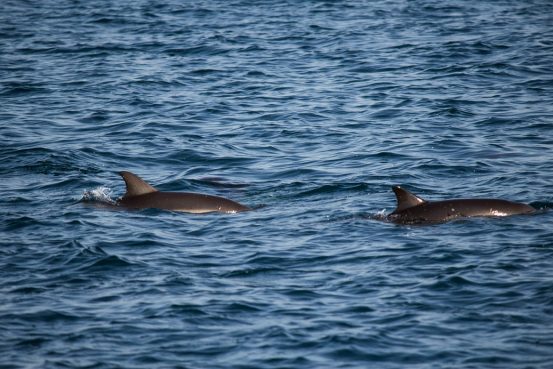Studying Dolphins on the Outer Banks
Jessica Taylor has her dream job. As President and founder of the nonprofit Outer Banks Center for Dolphin Research, she is often on the water researching a marine mammal that fascinates her.
“I think they’re so interesting. They’re so similar to people. Their societies, their relationships to each other,” she explains. “There’s a strong bond between the mom and calf through the first three to six years. The mom teaches them to catch fish, and whoever the mom is friends with, they hang out in nursery groups and they form bonds in the nursery that can last their entire lives. The males will form male pairs when they get older, and I find it interesting how they will stick together.”
Jessica’s journey to the Outer Banks began as an undergraduate student at Rutgers University in New Jersey where she majored in marine biology. Then, there was a year of intern work followed by two years at the Nicholas School of the Environment at Duke University.
She went back to New Jersey for a year. “I found a teaching job…teaching marine biology in an alternative school…but it wasn’t really the type of teaching I wanted to do,” she says.
After her year in New Jersey she moved to the Outer Banks for dolphin research. She also taught science at First Flight Middle School.
“When I was looking at moving here, the job I wanted to do – the dolphin research – was seasonal, so I was looking for something I could do for the rest of the year. I like teaching and I thought it might be a way to get kids involved with dolphin research,” she recalls.

After four years, the beginnings of a family took her away from teaching. Since then, she has been President of The Outer Banks Center for Dolphin Research.
“When I stopped teaching I had more time to concentrate on the program,” she says.
The Center for Dolphin Research relies on volunteers working as interns to do much of the work. “We started an intern program for students who just graduated from college,” she says.
Because of the meticulous collection of data that is being done, a better understanding of bottle nose dolphin behaviors along coastal North Carolina is emerging. Individual dolphin are identified by the visual differences of their dorsal fins, differences that become apparent as the dolphin age.
“We have about 700 dolphin catalogued since 2008,” Jessica notes.
The work she does is very focused. “I usually only work in Roanoke sound because it’s a small sound connected to the ocean,” she says.
What she is finding is remarkable.
“What I’ve been looking at most recently is the numbers of dolphins that are in the sound. To determine if year by year the numbers are increasing or decreasing; who the residents are, and who the transients are,” she says.
“We definitely have resident dolphins that we see consistently from year to year. And we have a much larger group of transient dolphins,” Jessica says adding a surprising statistic. “The program we are using estimated the number of dolphins we have in the sound at any one time is 1100.”
What has also been shown is that various groups and pods of dolphin seem to split their time between the Outer Banks and Bogue Sound and Onslow Bay around Beaufort.
Because food is more plentiful in the waters of the Outer Banks during spring and summer, this area seems to be where the dolphin come to breed and calve.
“There’s a peak birthing season in the beginning of the summer, in May or June,” she explains. “It’s better to have a calf in the early summer when the water is beginning to warm up and there’s more food.”
The summer is the best time to spot dolphin swimming in Outer Banks waters. It’s also the time of the year that Jessica works with Nags Head Dolphin Watch as an interpreter on their cruises. And after observing the dolphins in the sound for a number of years, she has noticed what may be a reciprocal level of engagement on the water.
“They interact with the boat. I’ve seen them pop their heads up and look at us. They definitely know we’re there.”
